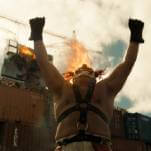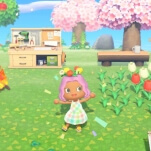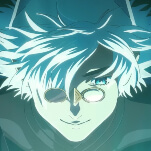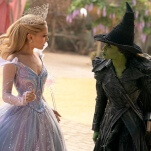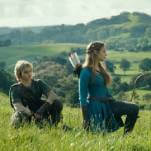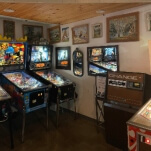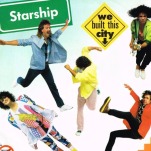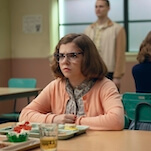Food is the catalyst for comic book romance in Bloom and Meal


Food and romance are tightly linked. Dates often happen at restaurants, cooking a lavish meal for your partner is an act of affection, and major relationship milestones are celebrated with food. There’s intimacy in both cooking and eating, in sharing the experience of making and consuming dishes that nourish the body and stimulate the senses. Two new graphic novels, First Second’s Bloom and Iron Circus’ Meal, explore this intimacy through two very different areas of cuisine: pastry baking and entomophagy (eating insects). Both titles use food to advance queer romances, bringing lovers together by sharing culinary traditions and making new discoveries.
Bloom, written by Kevin Panetta with art by Savanna Ganucheau, follows the son of two bakers as he tries to escape his family obligations and pursue the life of a musician in the big city. Ari’s parents need his help to keep their struggling Greek bakery afloat, but his attempt to find a replacement ends up giving him a new reason to stay when he meets Hector, a gay college student who moves to town to pack up his late grandmother’s home. Ari falls for him hard, but doesn’t know how to express his emotions or negotiate these new desires with his wishes for a fresh start away from his parents’ business.
With its soft blue palette, beachfront setting, and story about a young person at a personal crossroads, Bloom is reminiscent of First Second’s award-winning This One Summer, but it’s not as complex or challenging. Bloom is dessert; sweet and satisfying in the moment, but not particularly filling. Ari doesn’t fully acknowledge or engage with his parents’ financial crisis, which rings true for that period of life when young adults become selfishly fixated on their own futures and shut out the needs of others if they don’t align. But the tension between Ari’s dreams and his family’s reality would be stronger if Panetta gave the reader more insight into the parents’ money woes, painting a more specific picture of the adult problems that Ari willfully ignores.
There’s no pressure on Ari to be in the closet, but it’s clear that he is struggling with his feelings for Hector and fully accepting his queer identity. Subtext plays an important role in this struggle. Ari dotes on one of his male bandmates who is constantly belittling him, and while it’s not explicitly stated, there’s a sense that this is an early crush that has defined much of Ari’s plans for the rest of his life. Much of this subtext comes from Ganucheau’s artwork, which imbues Ari with a sullen disposition that accentuates his fundamental unhappiness. By contrast, Hector is self-assured and cheerful despite much sadder circumstances. His enthusiasm for baking is a turn-on for Ari, who becomes less gloomy as they spend more time together over the summer.
The best moments in Bloom are the sequences showing characters bonding over baking. Ganucheau’s layouts transition to two-page spreads with rounded panels that roll across the page, changing the rhythm of the visuals to reinforce how the act of baking puts people in a new headspace. The book’s title refers to both flowers and baking—bloom is another word for proof, the process of letting dough sit so that it can rise before baking—and this dual-meaning comes into play during these scenes as Ganucheau incorporates floral imagery between panels. The romance at the core of Bloom is very soft and delicate, and like flowers and baked goods, this relationship requires time to grow. There’s one baking sequence featuring Ari’s parents making phyllo dough, and while it still features the rolling layout, there are no flowers present. Their collaboration has become so habitual over the years that baking is not an overtly romantic process for them the way it is for Ari and Hector, but watching the two parents move in sync is still inspiring to the two young men.
Baking is an essential part of Bloom’s storytelling, but ultimately the food is secondary to the romance. That’s not necessarily a problem, it does make the baking feel like it could be replaced by a different craft and the story wouldn’t change very much. That’s not the case with Blue Delliquanti and Soleil Ho’s Meal, which relies entirely on the food to push the story forward. Released at the end of last year, Meal delves deep into the history and process of preparing insect cuisine. It’s an exceptional cooking comic, whetting the appetite for these unconventional dishes with appealing descriptions and illustrations that enrich the characters’ personal attachment to what they’re eating. It gives readers specific action items to try out in their own kitchens and an anthropological exploration of what this food means to different cultures, tying them both into a compelling conflict centered on appropriation in the food industry.
Meal is less than half the length of Bloom, but it’s a more substantial read because the creative team covers a wider spread of topics while maintaining strong emotional through-lines from beginning to end. Romance is just a part of the plot, with food being the thing that brings the couple together and keeps them together. Yarrow is an entomophagy advocate who wants to land a job at a new restaurant dedicated to spreading the gospel of insect eating, and the story begins with Yarrow cooking a mealworm curry for her neighbor/crush, Milani. This opening serves as a welcoming introduction to entomophagy, giving Delliquanti and Ho the opportunity to sell insect eating to the reader and make it enticing through Yarrow’s interactions with Milani.
Delliquanti makes a wise decision in co-writing the book with Ho, a chef, writer, and podcaster with a rich understanding of the central topic. Delliquanti has crafted a story about cultural appropriation, so she collaborates with a writer who can broaden her understanding with an informed perspective. Ho brings the culinary expertise, and Delliquanti translates that into an engaging story that educates without diminishing dramatic stakes or slowing down the story’s momentum. That education continues in Meal’s excellent backmatter, which starts with an essay from Ho, who writes lovingly about entomophagy and its rise in the U.S. food scene. There are also three recipes for tacos de chapulines (crickets), pan-fried tarantula rolls, and bee larvae honey drops, all of which are accompanied by illustrated commentary from characters in the book.
When Yarrow goes in for an interview, she’s immediately dismissed by the head chef, Chanda, because the reasoning for her passion sounds too much like someone trying to exploit a different culture’s cuisine in hopes of starting a foodie trend. Yarrow is given three days to come up with a taco recipe that will impress Chanda and prove her worth to the operation, and she uses that time to research recipes that will reveal her true appreciation and eliminate Chanda’s doubts. The specificity of the culinary aspects in Meal informs a lot about Yarrow’s character. The unfortunate word choice in her interview sours Chanda, but the reader knows that Yarrow really cares about entomophagy and isn’t trying to cash in on the novelty.
Finding the right recipe is part of the solution for procuring a job, but equally important is Yarrow appropriately describing her personal attachment to eating insects and how it’s been a part of her life going back to her childhood. Milani proves to be a valuable ally in this regard, and her work as a visual artist who creates pieces rooted in memory makes Yarrow realize that her past experience will help Chanda see the purity of her intentions. Yarrow and Milani’s relationship is rewarding, but it falls apart once it takes a turn for the romantic. When Yarrow goes in for a first kiss, her action triggers Milani’s feelings of insecurity and her fears of ruining a good friendship by pushing it into romantic territory.
Milani is too invested in the success of Yarrow and the restaurant to turn away completely, especially because she’s created the mural that serves as the restaurant’s facade. At the fair that serves as the restaurant’s public debut, Milani is the person who compels the crowd to try food that they initially find repulsive, taking the first bites and fervently praising the flavors. One of the most powerful images in Meal comes after Milani takes a bite out of the tacos de chapulines, which summons a rush of natural imagery that reflect the earthy taste as well as faded silhouettes of all of the people responsible for bringing that dish to Milani’s mouth. Chanda and Yarrow are most prominent, but the rest of the restaurant staff appears in the background, visualizing how each person plays a plays a part in giving patrons a delicious experience. The food is the connective tissue between all these individuals, and by emphasizing the cuisine, Delliquanti and Ho showcase how cooking and eating creates bonds between friends, lovers, and the strangers who sustain themselves with what these relationships produce.
GET A.V.CLUB RIGHT IN YOUR INBOX
Pop culture obsessives writing for the pop culture obsessed.

